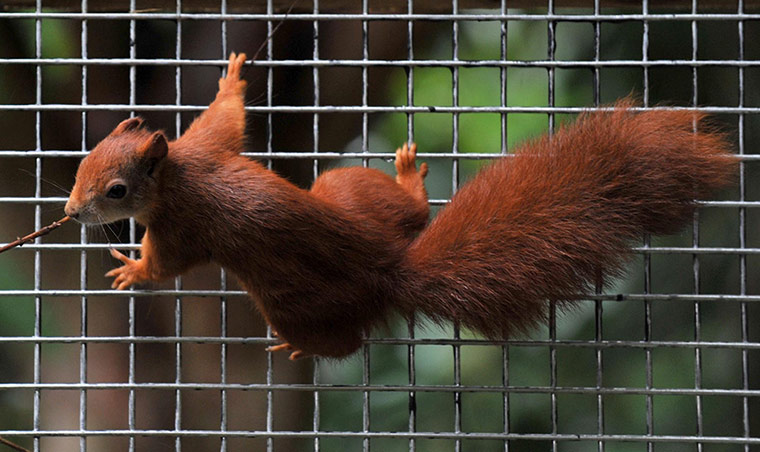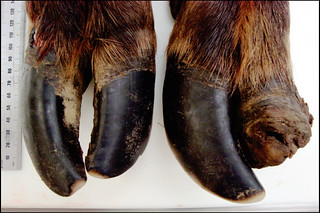TOP STORIES
Unexplained Hoof Disease Spreads Quickly In Washington Elk
It began with a few isolated cases and is now common in herds across the region, from Vancouver to the foothills of Mount St. Helens. Hunters first spotted elk limping near Longview Washington in the 1990s. They reported the animals’ hooves were deformed or missing.
... Kristin Mansfield, a veterinarian with the Washington Department of Fish and Wildlife, says the disease hasn’t caused a decline in Washington’s elk population yet, but it may if it continues to spread to new herds.
Mansfield says the disease doesn’t match any other reports of elk maladies in the United States. Forms of hoof rot do appear occasionally in Wyoming’s populations of elk that congregate around feeding sites. Mansfield says those reports of hoof disease are limited to winter and to a few individual animals.
Oregon Public Boardcasting - www.opb.org
06 Sep 2012
A Templeton
Location: Mount St. Helens, Washington, USA
Climate could increase flu among wild birds
Climate change could cause an increased risk of avian influenza transmissions among wild birds, say scientists.
Population ecologists Pejman Rohani and Victoria Brown at the University of Michigan used a mathematical model to explore the consequences of altered interactions between an important species of migratory shorebird and horseshoe crabs at Delaware Bay as a result of climate change.
They found that climate change could upset the carefully choreographed interactions between ruddy turnstone shorebirds and the horseshoe crabs that provide the bulk of their food during the birds’ annual stopover at Delaware Bay, a major estuary of the Delaware River bordered by New Jersey to the north and Delaware to the south.
Climate change-caused disruptions to the well-timed interplay between the birds and crabs could lead to an increase in the avian influenza infection rate among ruddy turnstones and resident ducks of Delaware Bay, the researchers found.
Futurity - www.futurity.org
04 Sep 2012
Journal Article Cites
VL Brown and P Rohani. The consequences of climate change at an avian influenza ‘hotspots'. Biology Letters. 2012; [Epub 29 Aug 2012]
Waterfowl disease prompts DNR to close islands as hunting begins
Detection of a disease that strikes various waterfowl has prompted the closure of islands in two southern Minnesota lakes, officials announced Friday.
The state Department of Natural Resources (DNR) is closing the islands in Minnesota Lake, near Mankato, and Pigeon Lake, west of the Twin Cities near Dassel, to waterfowl hunters and other lake users.
The closures come after the National Veterinary Services Laboratory in Ames, Iowa, confirmed the disease, called Newcastle, from samples collected during the cleanup of dead cormorants in early August.
Islands in other lakes throughout the state could face the same fate. Results from samples submitted from bird die-offs are pending. Some of those lakes include Mille Lacs; Johanna near Glenwood; Pelican near Brainerd; Chautauqua and Pelican near Fergus Falls; and Wells near Faribault.
Star Tribune - www.startribune.com
31 Aug 2012
P Walsh
Location: View locations of cases reported in Minnesota, USA on Disease News Map 
Avian botulism showing up in birds again
After a quiet 2011, Antrim County propery owners along the shores of Grand Traverse Bay are once again being asked to keep their eyes open for dead waterfowl and shorebirds on their beaches with the re-appearance of deadly avian botulism believed to be responsible for the deaths of a number of birds along the eastern shores of Lake Michigan in recent weeks.
Loons, scoters, grebes, and piping plovers are among thousands of birds found dead, with Type E botulism confirmed as the cause of death by the Michigan Department of Natural Resources in bird carcasses collected from several locations along the Lake Michigan shoreline.
Antrim Review - www.antrimreview.net
06 Sep 2012
L Gallagher
Location: Grand Traverse Bay, Michigan, USA - Map It 
Other Wildlife Health News in the Great Lakes Region
Lake Eerie Mystery: Dead Birds, Fish, Wash Up By The Thousands Causing Massive Stink [Lake Erie, Ontario, Canada - Map It  ]
]
OTHER WILDLIFE HEALTH RELATED NEWS
Photo courtesy of The Guardian's feature, Week in Wildlife
 |
|
A project in Cornwall aims to reintroduce captive-bred reds back into grey squirrel-free exclusion zones over the next five years |
- Emergence of a European parasite in Western Canada [CCWHC Blog]
- Report blames wildlife dept for peafowl deaths in Thar [View earlier reports of outbreak on Disease News Map
 ][Pakistan]
][Pakistan] - Disease outbreak continues to kill white-tailed deer [View new cases in Michigan reported on Disease News Map
 ][Michigan, USA]
][Michigan, USA] - Record High Number of Beluga Calf Mortalities Reported in the St. Lawrence Estuary [St Lawrence Estuary, Quebec, Canada - Map It
 ]
] - Emergence of a European parasite in Western Canada
- Study shows how racoons are spreading dangerous diseases around Europe [Cited European J Wildl Res HERE]
- SUMNER COUNTY DEER DID NOT HAVE CHRONIC WASTING DISEASE [Kansas, USA] (Courtesy of a fellow Digest reader)
- Dead birds in RI, Henry counties test positive for West Nile [View location of cases on Disease News Map
 ] [Illinois, USA]
] [Illinois, USA] - More birds with West Nile virus discovered in East Bay [View Disease News Map
 ][California, USA]
][California, USA]
- Great White Shark Washes Ashore; Officials Close New England Beaches [Cape Cod, Massachusetts, USA - Map It
 ]
] - Fourth rescued whale dies after Fife mass stranding [Pittenweem, Scotland - Map It
 ]
] - 22 whales beached on Florida coast; 5 survivors fight for lives [Avalon Beach, Florida, USA - Map It
 ]
]
- Chimps Infected with Human Diseases Pose Possible Risk to Reintroduction Efforts [Cited Am J of Primatology article HERE]
- What Caused the Yosemite Hantavirus Outbreak? [Scientific American] France investigating two suspected cases of deadly Yosemite virus
- Nine cases of EHD reported in Nebraska cattle
- 'Alien mammal' invasion of Europe (Courtesy of fellow Digest reader)
- Tigers 'take night shift' to dodge humans (Courtesy of fellow Digest reader)






No comments:
Post a Comment